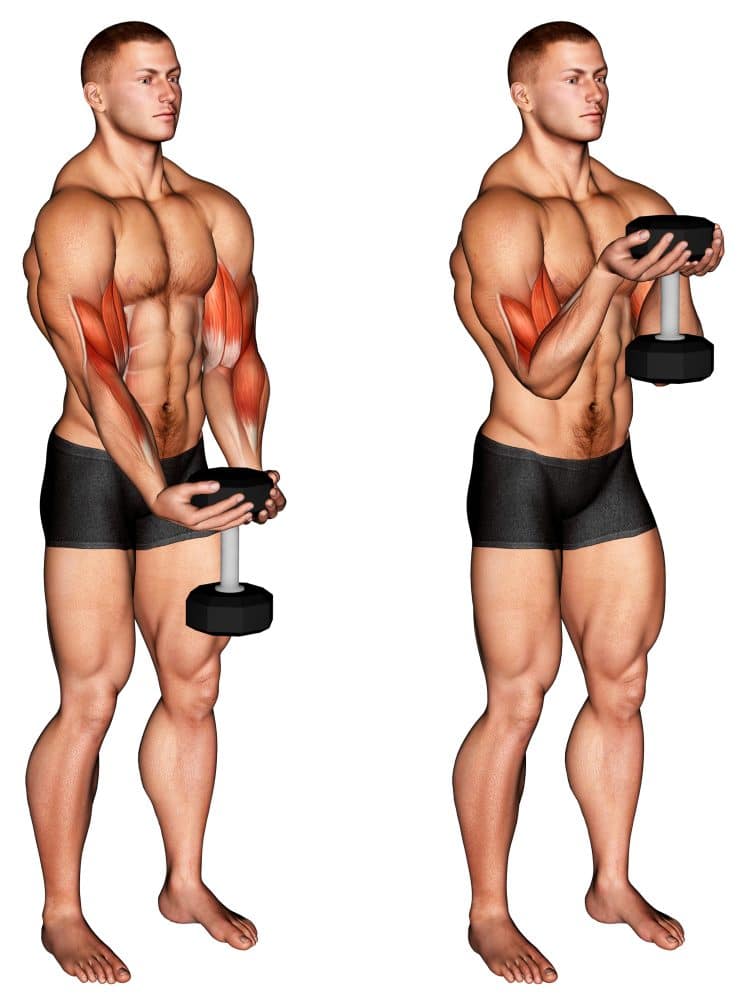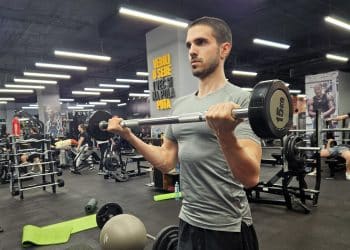It’s no secret that most lifters love training arms. Big guns symbolize strength, after all. However, most people stick to vanilla exercises like the barbell curl and dumbbell curl in their arms training regimen. No wonder most people have twigs for arms.
While there is nothing wrong with these exercises, trying new exercises like the waiter curl can be incredibly effective in adding size, strength, and definition to your arms, especially if you have hit a plateau.
Contrary to what most people think, the biceps dumbbell curl doesn’t only train your biceps peak. Compound bis curling exercises train your biceps brachii (long and short head), brachialis, brachioradialis, and forearm flexors.
While these compound lifts are great for building biceps size and strength, they aren’t the most optimal for building conditioning and separation.
Enter biceps waiter curl.
The waiter curl was developed and popularized by Jeff Cavaliere of the Athlean-X fame. The exercise target the long head of your pythons using a clever grip on the dumbbell.
Level Up Your Fitness: Join our 💪 strong community in Fitness Volt Newsletter. Get daily inspiration, expert-backed workouts, nutrition tips, the latest in strength sports, and the support you need to reach your goals. Subscribe for free!
It isn’t clear why Cavaliere named it the waiter curl. However, it’d be safe to say that the exercise got its name because you look like a waiter carrying a tray while at the bottom of the movement.
Adding the waiter curl to your training regimen can improve your biceps’ long head, making your pythons look more peaked and separated, especially when viewed from the sides or behind.
Muscles Worked
The waiter curl primarily works the biceps brachii and more specifically, the long (outer) head of the brachii. Additionally, the lift also targets your forearm flexors and brachialis.
The brachialis lies beneath the brachii and is one of the largest elbow flexors that provides forearm flexion at the elbow. The waiter curl also activates the forearm flexor, a group of five muscles that help move the forearms through pronating and supinating.
Since there is constant tension on your arms during the isolation lift, it results in brachii, brachialis, and forearm flexor activation.
How To Perform Waiter Curl
This is how to perform the lift with the correct form —
- Place a dumbbell on an elevated surface like a bench in a vertical position. This will make the next step easier.
- Place your hands flat under the top plate with one hand on each side of the dumbbell’s handle in a supinated position.
- Make sure you’re not gripping the plate. Hold the dumbbell like a waiter holds a tray.
- Stand upright with a shoulder-width stance and hold the dumbbell in front of your thighs.
- While keeping your elbows pinned to your sides, curl the dumbbell until it is at your chest height.
- Pause and contract your pythons at the top.
- Slowly return to the starting position.
- Repeat for reps.
Note: While performing the exercise, you will follow a restricted range of motion. Extending your arms at the bottom will ease tension off your brachii and lead to greater forearm recruitment.
Waiter Curl Tips
- De-emphasize the forearm flexors and put more focus on the biceps by trying to rotate your wrists outward as you curl the dumbbell.
- Ensure that the top of the dumbbell faces straight up throughout the motion. Do not let the top of the dumbbell be at an angle as you perform the curl.
- Keep your shoulder blades pressed back throughout the exercise, or they could roll forward, leading to aches, pains, and injuries over time.
- Waiter curls are designed to be performed to fatigue or borderline failure for the greatest muscle stimulus. Muscle hypertrophy should be your goal while performing the exercise.
- Waiter curl is not the best exercise if your goal is to build strength. Performing 3-5 reps on the waiter curl isn’t going to do much good.
- Do not wrap your fingers around the dumbbell, even during the last few reps. Caving in your hands will lead to brachialis engagement as you’ll be holding the dumbbell with a neutral grip.
Related: How To Write Your Own Fat Loss Or Hypertrophy Program
Common Mistakes
Some of the most common mistakes while performing the waiter curl include —
1. Tilting the Dumbbell
While performing the exercise, many lifters tilt the dumbbell forward, which leads to tension coming off your bicep peak. If the dumbbell is titled even slightly, it’ll put greater stress on your wrists and forearms, beating the purpose of the exercise.
Keeping the dumbbell vertical throughout the lift is like performing a strict curl. Furthermore, make sure you’re not using any momentum by swinging back and forth.
2. Going Too Heavy
Since the exercise only involves curling a single dumbbell with both arms, many lifters, thanks to their inflated egos, end up using more weight than they can handle and messing up their form.
If you use a dumbbell that is too heavy, you’ll end up wrapping your fingers around it and won’t be able to hold it like a tray. Use a weight that you can hit failure on in the 12-15 rep range. While choosing a weight, factor in the two-second rest at the top of each rep.
Check Out: Rep Range For Maximum Muscle Mass
3. Following a Full Range of Motion
The range of motion while performing a waiter curl is shorter than that of a traditional dumbbell curl. You do not have to fully extend your arms at the bottom of the movement. Furthermore, you won’t be able to fully extend your arms as you’ll hit the other end of the barbell on your thighs.
Level Up Your Fitness: Join our 💪 strong community in Fitness Volt Newsletter. Get daily inspiration, expert-backed workouts, nutrition tips, the latest in strength sports, and the support you need to reach your goals. Subscribe for free!
Restricting your range of motion while performing the exercise will help you focus on your bicep peak. Remember — the goal of this exercise is to leave with a nasty pump.
Waiter Curl Benefits
Adding the waiter curl to your exercise arsenal entails the following benefits —
1. Isolating Your Biceps
If you have hit a plateau, performing the conventional dumbbell or barbell curl isn’t going to make much of a difference. You will need exercises that target your bis differently, and this is where the waiter curl shines.
Since you’ll be holding the dumbbell with a narrow grip, it’ll help isolate and activate the long brachii head (bicep peak). If you are trying to improve your bicep peak, the waiter curl will be an asset in your exercise arsenal.
2. You Lack Equipment
Many people work out at home and have access to limited training equipment. Since the waiter curl requires just one dumbbell, it puts you at the liberty to invest in your garage gym one dumbbell at a time.
On the other hand, the waiter curl can be a lifesaver for people who train during the rush hour at the gym, especially in facilities with a single pair of dumbbells for each weight.
3. Great For Lifters of All Experience Levels
Whether you are a newbie or an advanced lifter like Jeff Cavaliere, the waiter curl has something for everyone.
Since the exercise has a limited range of motion and is a functional movement that is not too hard to learn, it can be picked up by the beginner rather quickly. The same cannot be said for exercises like the Romanian deadlift or sumo squats, both of which have a learning curve.
Once a lifter gets proficient at performing the lift, advancing in the weight doesn’t take much time as the exercise involves lifting a dumbbell with both hands. It helps the lifter constantly challenge their muscles, helping ignite muscle and strength gain.
Related: The Functional Training Split: Overview, Benefits and Sample Workouts
4. Reduces Risk of Injury
The waiter curl is an isolation exercise that targets your long brachii head. Since you can only use a single dumbbell while maintaining perfect form, the chances of an injury due to muscle overload reduce significantly.
5. Great Finisher
Most lifters like to leave the gym with a muscle-ripping pump. A sick pump is one of the best indicators, although scientifically not necessary, of a good workout.
Waiter curl is a great exercise to fill your pythons with blood and lactic acid and keep at it until your muscles beg you for mercy. The contraction at the top will get more intense with every rep. Don’t be surprised if you’re sore for days after the workout.
Waiter Curl Alternatives and Variations
Here are some of the most effective waiter curl alternatives and variations —
1. Chest-Supported Incline Bench Waiter Curl
Since the incline bench waiter curl is a more intense isolation exercise than the conventional version, you might have to be content with using a lighter weight.
How to:
- Set an incline bench so that it is at a 45-degree angle to the floor.
- Place your abdomen against the back support so that your middle chest is at the edge of the pad.
- Hold a dumbbell in the waiter curl position as mentioned above. You could use a spotter to help you with the dumbbell.
- At the starting position, your arm should be extended straight down so that they are perpendicular to the floor and directly under your shoulders.
- While keeping your elbows pinned in position, curl the dumbbell until it is at your shoulder height.
- Pause and contract at the top.
- Slowly return to the starting position.
- Repeat for recommended repetitions.
2. Seated Barbell Curl
The seated barbell curl is one of the most underutilized biceps exercises. It is incredibly effective at helping improve your biceps peak and developing explosive strength in the upper half of the curling movement.
How to:
- Set up for the seated barbell curl by placing a flat barbell at one end of a bench.
- Sit on the bench and place the bar on your thighs.
- Grab the bar with a shoulder-width grip using an underhand grip.
- Your back should be straight, shoulder pulled back, and feet directly under your knees.
- While keeping your elbows pinned to your sides, lift the barbell until at your chest height.
- Pause and contract your pythons at the top.
- Return to the starting position slowly. Do not let the weight touch your thighs at the bottom.
- Repeat for recommended reps.
Related: Grip Tips For More Productive Workouts
Wrapping Up
Who doesn’t want guns that give you bragging rights? However, building guns like Arnold Schwarzenegger is easier said than done, and sticking to the orthodox biceps curls will only get you so far.
Waiter curl is a great isolation exercise that will take your biceps game to the next level. Give it a try the next time you are in the gym, and let us know how it went.
Interested in measuring your progress? Check out our strength standards for Barbell Curl, Dumbbell Curl, Deadlift, and more.









